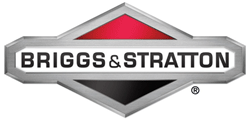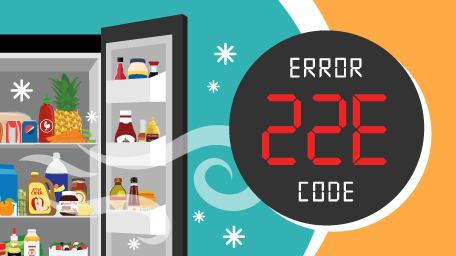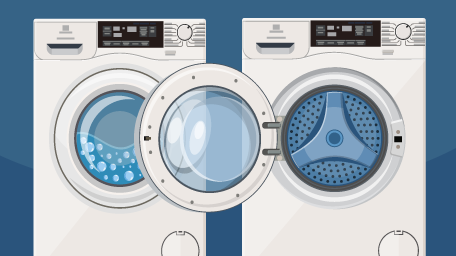
How to Resolve the Samsung Washer 4C/4E Error
The Samsung washing machine 4C error code is an indication that there is a water supply problem in the washer, typically caused by a fault in the water intake system. Depending on your washer model, you may see either 4C or 4E on the display, however, they mean the same thing, and whether you own a front-load or a top-load washer, the troubleshooting steps are the same for both error codes. Typically, the 4C or 4E error code have a few major causes: a control board glitch, clogged detergent dispenser/mesh filter, and a water valve behind the washer that's not fully opened are all very simple and common items to check first. The codes may also point to a greater underlying issue with your home's water supply, like low water pressure issues, or more serious still, a burst/frozen pipe. These issues will require immediate attention. In terms of parts, the water inlet valve is the most likely faulty component to cause this code, so if you've checked the other common issues, this part will remain the one to troubleshoot. By the end of this guide, you will fully understand these causes of the 4C or 4E error and be well-equipped to find the fault and clear the code.
6 Causes of the Samsung Washer 4C/4E Error Code and How to Fix Them
Control Board Glitch
The control board manages and controls all of the washer's functions. If it experiences a glitch it may be unable to monitor or measure the water levels in the washer or communicate that there is sufficient water. Resetting the washer should resolve any minor issues and clear the 4C or 4E error. However, if the error is still present after resetting the washer, then you will need to move through the troubleshooting instructions provided below.
How to Reset (Power Cycle) Samsung Washer to Fix the 4C or 4E Error Code
- Unplug the washing machine from the power outlet, and wait 1 - 3 minutes before plugging it back in.
- If the method above does not work, try switching off the power at the circuit breaker. Wait for 1 to 5 minutes, and then switch the power back on.
Clogged Detergent Dispenser
If you regularly use more detergent than is recommended or use non-HE (high efficiency) detergent, the detergent dispenser may become clogged with built-up soap residue. A clogged dispenser drawer might cause water to overflow or not flow correctly within the washing machine, thereby triggering the 4C (4E) error. You will need to remove the buildup to fix the error. To maintain the longevity of your washer, be sure to use the correct amount of detergent and consider opting for liquid detergents which are less likely to cause build-ups than powdered ones.
How to Clean the Detergent Dispenser to Fix the 4C or 4E Error
- Ensure the washing machine is turned off and unplugged from the electrical outlet before starting any cleaning.
- Open the dispenser drawer and push down on the release lever while pulling the drawer out at the same time.
- Clean the drawer using warm, running water or fill the sink basin with warm water and allow the detergent dispenser drawer to soak for a few minutes.
- If the build-up is heavy, use a soft brush or an old toothbrush and a mixture of equal parts water and white vinegar to help dissolve the residues.
- Using the same brush or a damp cloth, gently scrub the inside of the compartment where the detergent drawer sits in the washing machine.
- Once everything is clean and dry, slide the detergent drawer back into its slot.
- Run a short cycle to confirm that the error code has cleared and the water flow is restored.
Low Water Pressure
If the water flowing into your washing machine from the main water supply has low pressure, the washer may not fill up in the set time, or may not fill up at all, resulting in the 4C or 4E error. Your pressure reading should fall between between 20 psi and 120 psi. If it falls out of this range, you should check that the valves are fully open and the hoses are well connected. You can test the water pressure of your home's water supply using a water pressure test gauge or by calling your local water utility company.
How to Test Water Pressure Levels for Your Samsung Washer
- Pull the washer away from the wall to access the main water supply valve.
- Place a dish or towel underneath the water supply hose, and slowly disconnect it from the valve.
- Attach a pressure gauge to one of the valves and turn the valve until it is fully open.
- Check that the reading on the gauge falls within the standard range needed for your washer.
If you confirm water pressure issues in your home when troubleshooting this error code, it's important to note that you could be dealing with a frozen/burst pipe issue, especially if you've been experiencing below-freezing temperatures in your area and you have exposed pipes in uninsulated areas of your home. The 4C/4E error code will appear on your washer, but water pressure/supply issues will be prevalent throughout all water sources in your home. It is important to call a plumber immediately if you fear you may be dealing with a frozen or otherwise burst pipe.
Water Tap Not Fully Opened
The water supply tap is a manual valve found on the wall behind the washer. When it is open, it allows water to flow to the washer. If it is not completely open, the flow of water will be restricted and insufficient to run the washer, triggering the 4C (4E) error.
How to Open the Water Tap to Fix the 4C or 4E Error Code
- Turn the washer off and disconnect it from the power source.
- Pull the washer forward to access the back wall.
- Turn the water tap counterclockwise as far as it will comfortably go to open it.
- Reconnect the washer to the power outlet and run a short cycle to ensure that the code is resolved and the water enters the drum without any issues.
Kinked or Blocked Water Supply Hoses
The water supply hoses, (inlet hoses) are responsible for transporting water from the home’s main supply to the washer. If the hoses are kinked or pinched, clogged, or they are not securely connected, they can restrict the flow of water, leak, and reduce the water pressure, resulting in the 4C error.
How to Clean the Water Supply Hoses to Fix the 4C or 4E Error Code
- Turn off the washing machine and unplug it from the wall outlet.
- Turn off the water supply valves for both hot and cold water.
- Pull the washer from the wall to access the water supply hoses.
- Confirm that the hoses are not bent awkwardly or pinched.
- Place a small dish or a towel underneath the water supply hoses, as water will likely spill out when you remove the hoses.
- Remove the mounting hardware that secures the hoses to the back of the washer.
- Next, disconnect the other end of the hoses from the water supply valves.
- Inspect the hose to check for any visible clogs or obstructions. If any are present, run high-pressure water through the hose or use a long brush to gently push it out.
- Once the hoses are clean you, screw the hoses back onto the washer and the water supply valves.
- Turn the water supply valves back on and check for any leaks.
- Plug the washer back into the wall outlet and run a short cold water cycle without any clothes in it. This will help flush out any remaining debris and ensure everything is working correctly.
Clogged Mesh Filters
The water supply mesh filters/inlet filters traps debris and sediment to prevents it from flowing into washing machine from the household water supply. These screens can get clogged over time and restrict the flow of water to the washer, resulting in the 4C (4E) error code. They should be cleaned regularly, and it is recommended to replace the filters every 6 months.
How to Clean the Mesh Filters to Fix the 4C or 4E Error Code
- Place a bucket or towels near the water supply hoses to catch any water that might spill out when you remove the hoses.
- Carefully unthread the water supply hoses from the back of the washer.
- Look inside the inlet valves on the back of the washer to locate the mesh filter.
- Remove the mesh filter using a pair of needle-nose pliers.
- If the filters are dirty, you can clean them under running water or use an old toothbrush to gently scrub away the buildup. You can also soak them in water and vinegar to loosen the debris.
- If the mesh filters are damaged or excessively worn down, you can use our model search feature to find new filters that are the correct size and type for your specific Samsung washer model.
- To install the new screens, gently press them into place inside the inlet valve fittings using your fingers.
- Reconnect the water supply hoses to the back of the washer.
- Turn the water supply valves back on and check for any leaks at the hose connections.
- Plug the washer back in and run a short rinse cycle to ensure the flow of water is restored.
Faulty Water Inlet Valve
The primary function of the water inlet valves is to regulate the flow of water into the washing machine. When your washer needs water for a cycle, the control board sends an electrical signal to the inlet valve, which allows it to open and allow water to flow into the drum. if it is damaged or experiencing an electrical fault, it will be unable to control the water flow or let water enter the machine, leading to the 4C (4E) error. To check for electrical failure, use a multimeter to test for continuity, if there is no reading you will need to find a replacement water inlet valve.
How to Replace a Faulty Water Inlet Valve
- Unplug the washing machine from the electrical outlet, and turn off the water supply to the washer.
- Move the washing machine away from the wall so you have enough space to work behind it.
- Place a small dish or towel underneath the water hoses and carefully disconnect the water hoses from the back of the washing machine.
- Locate the screws holding the rear panel of the washer in place and carefully unthread them to access the inlet valves.
- Unplug the wire connectors from the faulty water inlet valve.
- Remove the screws holding the inlet valve in place, and carefully pull it out of the washer.
- Position the new water inlet valve where the old one was, and mount it in place using the appropriate screws.
- Reconnect the wiring to the new valve.
- Place the back panel onto the washer and secure it with the screws you removed earlier.
- Reconnect the water hoses to the new inlet valve, ensuring the hot and cold hoses are mounted in the correct positions.
- Run a short cycle to test that the new valve is working correctly and to check for any leaks.

As you can see, there can be various reasons why your Samsung washer is displaying the 4C (4E) error. Addressing these issues promptly is essential to ensure the longevity and efficiency of your washing machine. Regular maintenance, such as checking the water hoses and cleaning the mesh filters, can reduce the chances of this error popping up. Being proactive will not only save you time and money in repairs but will also ensure that your laundry days remain hassle-free.



























